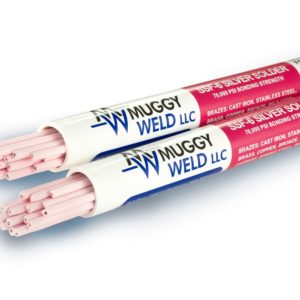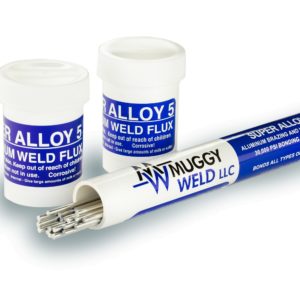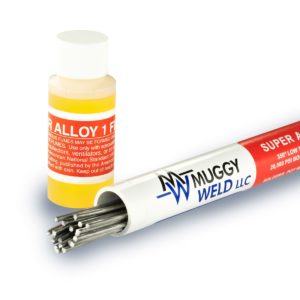John Deere 1010 Loader Repair with Muggy Weld 77
Phil Sherman of Portable Welding & Repair Services called us with a unique repair application. His John Deere 1010 loader’s bushing (which had been welded many times) was so worn it was no longer reparable and required a custom bushing. Phil constructed the mild steel bushing with a heavier wall than John Deere manufactures, and utilized Muggy Weld 77 cast iron electrodes to weld the bushing to the loader.
First, Phil needed to remove the prior welding products, using a grinder or wire wheel. When grinding out previous welds, it’s next to impossible to remove all of the old rod before beginning your cast iron repair. Why? Cast iron is soft and the new deposit just mixes in with the cast, so it is sometimes helpful to grind a little deeper to remove all the old electrode.
After precleaning and grinding both parts to create a flat surface for bonding, Phil secured the parts with a vice and proceeded with his repair.
Phil tack welded the two parts together, then drilled a hole at the end of cracks, peened between passes, and welded short beads (no more than 2 inches at a time) He was mindful of the parent metal temperature, keeping it at around 250 to avoid recracking the repair.
Note: When making these type of cast iron repairs, be sure to wait 1 minute between passes while keeping a close arc.
Phil decided to make a second pass, then allowed the part to cool naturally and painted the part yellow so he could easily identify any future cracks.
Tips:
- Soaking electrodes in water will help remove the coating for TIG welding. TIG welders usually use 3/32″ or for thinner cast or 1/8″ rods for heavier sections
- If the rod is not penetrating check the ground, amperage, and machine settings
- Low and slow is the key to a sound cast iron weld repair
- You can use a mild steel patch over large holes, both Muggy Weld 77 and 72 will weld steel to the cast iron
- Gently pre-heat the cast iron if possible, no need to get it red hot but it will lay flatter when you first start your bead and preheating removes moisture out of the cast to prevent pinholes and porosity in your repair
- If the cast iron rod undercuts, turn the amperage down
- If the cast iron rod looks ropey or doesn’t penetrate, turn the amperage up
Note: Please observe all AWS Safety & Health Guidelines when using Muggy Weld products.
Check Out These Products
-

Silver Solder Rod: Flux-Coated SSF-6 56% Brazing Rod
$69.00 – $260.00High-Strength, 56% Silver Solder Rod🌡 Melting Temperature 1150 / 621 ⇄︎ Bonding Strength 70000 psi, 482.63 MPa 🔧︎ Sizes Available (in) 1/16 🔧︎ Sizes Available (mm) 1.58 -

Super Alloy 5 Aluminum Welding and Brazing Rod
$69.00 – $109.00600°F aluminum welding, brazing, and soldering rod. Ideal for aluminum boat repair and cast aluminum.🌡 Melting Temperature 600 / 317 ⇄︎ Bonding Strength 30000 psi, 206.84 MPa

